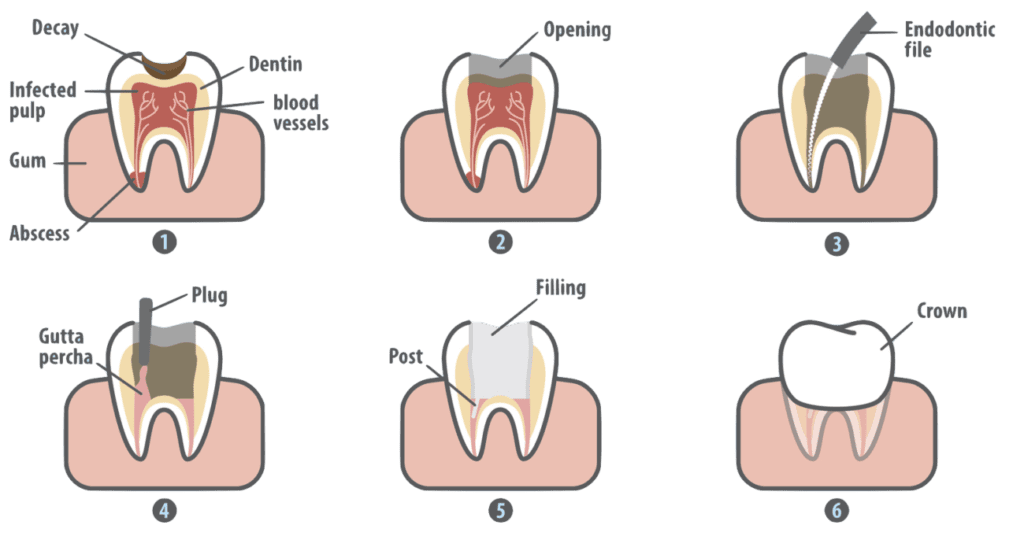A root canal has a bad reputation for being a painful and unpleasant experience. However, the truth of the matter is, a root canal is no more painful or involved than having a dental filling placed.
The pain associated with a root canal comes from the infection in the tooth that causes inflammation and pressure.
In fact, after a root canal procedure, many patients report immediate relief once the infection is removed from the tooth. Treating root canals are a part of Dr. Gauthier’s general dentistry services and are the best way to provide relief to patients who have deep tooth infections.
One of the greatest benefits of the root canal procedure is that you are able to retain your natural tooth rather than have it removed.
An infected tooth should be treated as soon as possible though to avoid the need for a tooth extraction. Tooth infection spreads very quickly, so it is crucial that you treat it sooner rather than later.
Dr. Gauthier performs root canal procedures in the comfort of his Northborough, MA dental office near you. He makes it his goal that patients are made to feel as comfortable and relaxed as possible before, during, and after treatment.

Root Canal Symptoms
The term “root canal” actually refers to the natural cavity at the center of the tooth. The tooth’s nerve is located inside the root canal, surrounded by soft tissue called the pulp. If the tooth is damaged or has decay, bacteria and debris can enter the root canal area and cause an infection.
How do you know if you need a root canal? Some patients do not experience any symptoms that would indicate the need for a root canal procedure; however, if the infection is not treated symptoms may present themselves in the form of severe pain.
Other patients, however, may experience painful symptoms as soon as the infection forms including:
- Severe toothache or tooth pain, particularly when chewing or biting
- Prolonged tooth sensitivity, especially to hot or cold foods and drinks
- Discoloration of the tooth (darkening)
- Soreness or tenderness to the gums surrounding the affected tooth
Getting a Root Canal in Northborough, MA
The root canal procedure may take anywhere from one to three visits, depending on the severity of the infection. First, Dr. Gauthier will take diagnostic X-rays to evaluate the condition of the tooth and root canal. An anesthetic may be administered to help the patient relax and relieve discomfort.
A small hole will be made to allow access to the inside of the tooth. The infected tissue and damaged nerve will be removed using specialized tools. The root canal will be thoroughly cleaned and disinfected to avoid future infection. If an infection is found, antibiotics may be prescribed, and the tooth will be temporarily sealed until the infection has healed.
Once the infection is clear and the root canal is free of debris, the interior of the tooth will be filled with a biocompatible material called gutta-percha that will serve to maintain the structural integrity of the tooth. The tooth will then be sealed back up.
Protecting the Tooth After Root Canal Therapy
Next, Dr. Gauthier will cover the tooth with either a dental filling or a dental crown to protect the root canal from future damage and add strength to the tooth. He uses CEREC technology to create and place the dental crown in just a single visit. The crown will be custom-fit and color-matched to blend in naturally with the rest of your smile.
After your root canal procedure, we recommend that patients schedule regular dental cleanings and examinations, so we can ensure that their teeth remain healthy and no further infections occur. After a root canal, it is crucial to continue practicing good oral hygiene to prevent bacteria from gathering around your restored tooth.
Root Canal FAQs
Do you have more questions about root canals? Continue reading to learn more about root canals and find answers to questions that are frequently asked in our office:
Do root canals hurt?
There is a popular myth that the root canal procedure is very painful. The pain patients typically associate with the root canal procedure commonly stems from the inflamed and infected tooth pulp.
Patients feel relief from painful symptoms after their root canal treatment. For patients with dental anxiety, our dental care team will work with you on an individual basis to help you feel comfortable and relaxed while receiving your root canal.
Should I get a root canal or have my tooth extracted?
Whenever possible, our Apex dentists strive to preserve as much of the natural tooth as possible. Root canals allow your dentist to remove diseased tissue without compromising the entire tooth. A dental crown can be used to help stabilize the treated tooth. Tooth extraction treatment may be necessary if too much of the tooth structure has to be removed to restore oral health.
Can I still get an infection after a root canal?
If you experience severe pain lasting more than a few days, swelling visible inside or outside your mouth, or the return of your original painful symptoms, your infection may still be present. Contact your dentist or endodontist if the pain hasn’t gone away after a few days. We provide second opinions and restorative consultations.
What’s the recovery like after a root canal?
The average patient will likely experience mild discomfort and sensitivity for a few days after the procedure. In most cases, over the counter pain medication can manage the pain. You will be able to resume normal activities immediately if you feel you are able to. It is important to maintain good oral hygiene while you are recovering. If you experience any severe pain or swelling, contact us right away.
What is the success rate of a root canal?
A root canal is a routine dental procedure with about a 95% success rate. When properly performed and when after care instructions are followed, they will provide long-term relief from pain and infection. Be sure to regularly visit your dentist and maintain good oral hygiene following root canal treatment. This will ensure long-term success and the longevity of the treated tooth.
How long does a root canal take?
A typical root canal treatment should take one or two appointments. Each should last about 1-2 hours. However, if you have a complex case, your appointments could last longer. Your dentist will be able to advise you about this after a consultation.
If you or a member of your family are experiencing discomfort due to tooth decay, please call (508) 506-1691. You can also request an appointment online.
